3. Scotland's Trade[13]
Transporting Scotland's Trade 2019 Edition
3. Scotland's Trade[13]
Scotland is home to a strong and productive economy, with a transport network that supports the functioning of over 345,000 businesses[14]. According to HMRC data, Scotland has the fastest growing goods exports of the four UK nations. Over the year to Q2 2019, Scottish goods exports grew by 14.5%, compared to growth of 2.7% in England, 6.8% in Wales and 6.8% in Northern Ireland. Contrastingly, Scotland's goods imports grew at the slowest rate of the four UK nations.
Over the coming years, Scotland's economic success will be increasingly realised through its ability to compete in an ever changing global market. Strengthening links with global economies brings with it increased trade, attracts investment and creates an environment to support the economy. International markets offer enormous potential for Scottish companies to share skills and expertise to boost exports.
Data from HMRC Regional Trade Statistics (RTS) allows for an up to date assessment of trade, disaggregated at the Scottish level. As the HMRC RTS deal solely with trade in goods[15] and not services, it also allows for more realistic analysis as services are less likely to 'travel'. Although data is currently available up to Q2 2019, for comparative purposes, the trade data used within this report will largely cover up to the end of calendar year 2018.
Scottish goods exports have increased each year since 2013, however, their contribution to wider economic growth measured in gross domestic product (GDP), has remained broadly unchanged over this period. A recent paper[16] published by the Scottish Government highlights ways in which Scotland as a nation can focus on key exports to boost competitiveness and strengthen its international ties, thus growing the economy at a faster rate.
Looking at Scotland in the context of the wider UK, 54% of all Scottish goods exports went to EU countries in 2018. Wales had the largest share of their exports going to EU countries – 61.3%. Three of the four UK nations had more than half of all goods exports going to EU countries. The only exception was England which has remained below half since 2013.
On the imports side, Scotland's EU imports account for just over 40% of total goods imports. Northern Ireland's imports from EU countries as a share of total imports was nearly 65% in 2018, whereas Wales imported less than 40% from EU countries. England's imports from the EU as a share of total imports has continued to increase. In 2013 the proportion was 53% and by 2018 this figure was up at 57% of all goods imports. Northern Ireland has seen an opposite trend over the same period, their share of EU imports falling from 71% in 2013 to less than 65% in 2018, nevertheless they continue to have the largest share of imports from EU countries across the four UK nations.
3.1 Exports
Figure 1: Destinations and Values of Scotland's Exports and Top 5 Export countries (£ billions), 2018
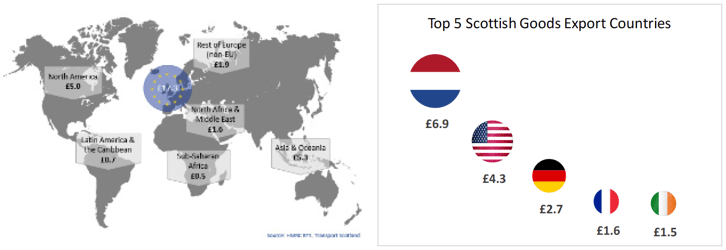
In 2018, international goods exports from Scotland totalled £32.2 billion. This was an increase of 12.7% compared to 2017. Of this total, non-EU partner countries accounted for 46%, a decrease from 51% the previous year, while exports to EU member states increased, now accounting for over £17 billion worth of goods exports.
Since 2013, the proportion of Scottish goods exports to EU countries has been broadly unchanged, although the total amount has increased. At its peak in 2014, 57% of all Scottish goods exports went to EU member countries. The gaps between the lines below show the amount of goods exports travelling to non-EU member countries.
Figure 2: Scottish Exports: EU vs. Non-EU
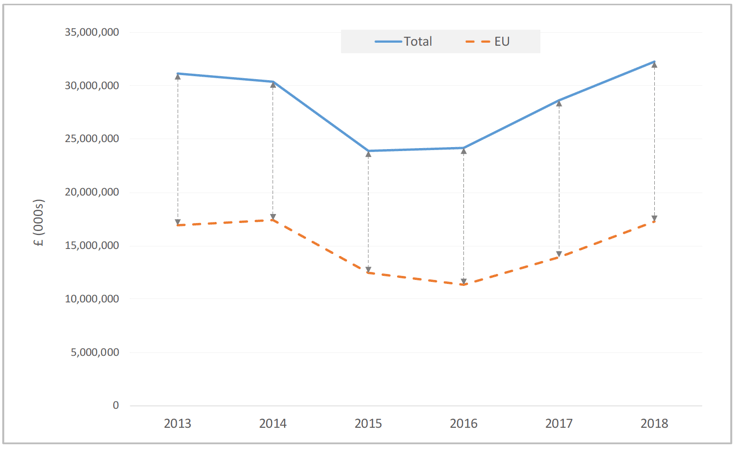
Key Markets
Scotland's top 5 export partners in 2018 were:
(1) Netherlands (£6.9 billion);
(2) USA (£4.3 billion);
(3) Germany (£2.7 billion);
(4) France (£1.6 billion);
(5) Republic of Ireland (£1.5 billion);
Over the past 5 years, Scotland's top 5 have evolved as shown in Figure 3.
Figure 3: Top 5 Scottish Goods Export Destinations over time, 2013-2018
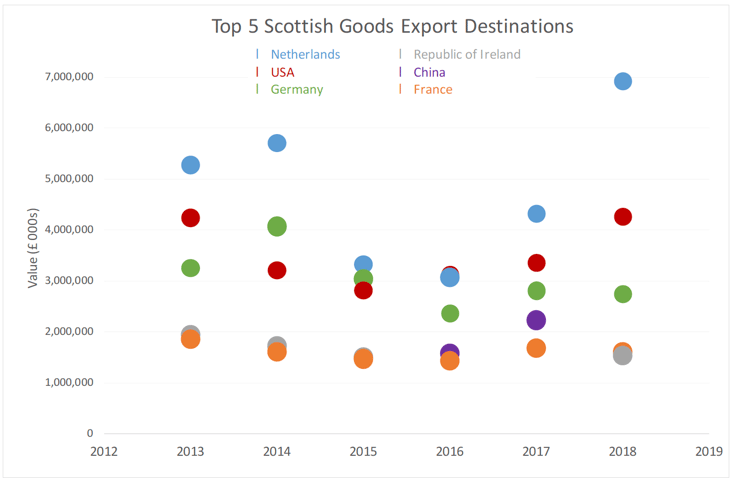
The Netherlands has been Scotland's largest export partner for 5 of the past 6 years – USA was the largest in 2016. Its dominance as Scotland's main export partner can be explained in part by the Dutch port of Rotterdam being an important international shipping hub (the largest port in Europe and 10th largest worldwide).
Many of the goods transported to Rotterdam will have another country, other than the Netherlands, as its final destination. These destinations are not routinely collected, which artificially boosts the value of exports to the Netherlands ('the Rotterdam effect').
China was one of Scotland's top 5 exporting partners in 2016 and through to 2017. However in 2018, the Republic of Ireland returned to the top 5, as exports of petroleum fuels to China more than halved compared to 2017, pushing China to 6th.
Scotland's top 5 goods export categories[17] in 2018 were:
(1) Petroleum products & related materials (£11.5 billion);
(2) Beverages (£4.3 billion);
(3) Power generating machinery & equipment (£2.6 billion);
(4) General industrial machinery (£1.2 billion);
(5) Fish, crustaceans, molluscs, etc. (£0.9 billion);
The above goods travel by some combination of modes (road, rail, port and air) before reaching their final destinations, with bulkier goods more likely to travel by road, rail and port.
Petroleum products & related materials includes a selection of refined fuels (oils and chemical fuels) which travel in different ways. Scottish oil exports are typically shipped out of dedicated oil terminals at Forth Ports, to a variety of locations. As mentioned above, China was a key recipient of oil exports in 2017, but in 2018 the value of exports to China in this category more than halved.
Despite global oil prices falling significantly in 2016, resulting in Scottish petroleum exports nearly halving, the sector has rebounded with export values close to those seen prior to the oil price crash. The value of petroleum products & related materials exports subsequently grew by over a third compared to 2017.
Scottish beverage exports increased by 7% compared to 2017. Although the United States are Scotland's largest beverage export market, between 2017 and 2018, beverage exports to the United States grew by just over 1%. Nevertheless, the USA still accounted for a quarter of all Scottish beverage exports in 2018. Scotch whisky[18], is the world's number one internationally traded spirit, with 41 bottles of Scotch whisky shipped every second to 175 global markets, totalling more than 1.2 billion bottles each year. Countries such as Ecuador, India, Malta and Sri Lanka all experienced strong growth in Scottish beverage exports in 2018.
Machinery exports (power generating and general industrial) from Scotland have a few key markets. In 2018, Scotland's top markets for power generating machinery were USA, United Arab Emirates (UAE) and India. Combined power generating machinery exports were valued at £1.1 billion, approximately 40% of all exports within the wider category. General industrial machinery exports primarily went to the USA, Germany and Norway. Singapore, China and Angola used to be key markets for these goods, but over time EU markets have received most of the exports in this category. This is the only one of the top five categories that has fallen in value each year, for the last 5 years.
Scottish seafood exports have increased by 58% since 2013, the fastest growing export market of the top 5 mentioned above, and were valued at £918 million in 2018. However, this value is around 3% lower than in 2017.
The fishing industry in Scotland is the largest in the UK. Landings at the three Scottish ports of Peterhead, Lerwick, and Fraserburgh account for just over 50% of all landings by UK vessels and 37% of the total value of the UK catch. In 2017, Scottish vessels landed 466,000 tonnes of sea fish and shellfish, with a gross value of £560 million[19]. Fishing is a major activity in Scottish ports, which is unsurprising given Scotland's location amongst some of the most productive fishing grounds in the world.
Over the past decade the number of Scottish fishing vessels has declined, with a shift towards larger boats, which have increased in number. Both the number of vessels and people employed have remained stable in more recent years, whilst the value and tonnage of landings has grown. In 2017, there were 2,065 active Scottish fishing vessels, employing 4,800 crew members, with over a quarter (27%) of vessels being over ten metres long.
In 2017, Scottish vessels landed abroad 180,000 tonnes of sea fish and shellfish, worth £121 million. The tonnage landed abroad increased by 12% and the real terms value of landings abroad decreased by 11% compared to 2016[20]. Norway is by far the largest destination for Scottish vessels landing abroad, accounting for 62% by tonnage and 74% by value of all Scottish vessels' landings abroad. Landings into Norway in terms of tonnage were largely unchanged from 2016, however the value of these landings have fallen by 8%. Landings abroad accounted for 39% of all landings by Scottish vessels in terms of tonnage and 22% in terms of value.
Figure 4: Top 5 Scottish Goods Exports by value, 2018
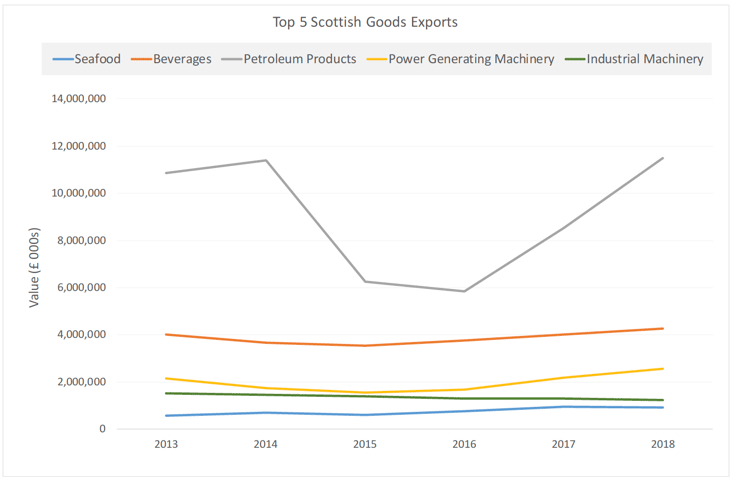
The volatile nature of oil and petroleum based products as a commodity and the impact that global phenomenon has on its price and supply means that as an export good, it can be relatively unpredictable. Scottish oil production in the North Sea is relatively small in comparison to more oil rich nations - such as members of the Organisation of Petroleum Exporting Countries (OPEC) - therefore any reduction in global demand is likely to heavily influence Scottish export levels. The other key exports, as shown above, have been relatively stable since 2013.
3.2 Imports
Figure 5: Countries of Origin and Values of Scotland's Imports, and Top 5 Import Countries (£ billions), 2018
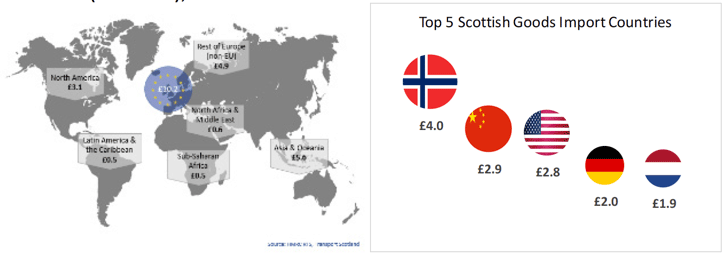
Scotland's total international goods imports were valued at £25.4 billion in 2018. This was an increase of 4.8% compared to 2017, although this growth was smaller than the growth in exports, so Scotland's trade surplus in goods increased.
Compared to 2017, Scotland's imports from EU countries increased by 11.8%, compared with a fall in imports from non-EU countries over the same period. As a result, trade from non-EU countries accounted for 60% of Scotland's goods imports by value, down by 2.5 percentage points from the previous year.
Key Markets
In 2018, 40% of goods imported into Scotland were from the EU (£10.2 billion). The top 5 countries from which Scotland imports from has remained unchanged over the past 5 years, albeit the ranking of countries has changed from year to year. Norway has led Scottish imports every year since 2013. As is highlighted by Figure 5 above, Scotland's leading sources of imports are:
(1) Norway (£4.0 billion);
(2) China (£2.9 billion);
(3) USA (£2.8 billion);
(4) Germany (£2.0 billion);
(5) Netherlands (£1.9 billion);
While the Netherlands also feature here, Scottish goods imports often have a greater level of tracking with regards to origin than Scottish goods exports. For this reason, it is likely that the degree of inflation due to the Rotterdam effect acting upon the value of goods Scotland imports from the Netherlands is significantly smaller than that acting upon its exports to the Netherlands. While the Netherlands may still be a hub for goods leaving continental Europe bound for Scotland, it is much more likely that Scottish businesses will be aware of the source of their imports.
While the composition of Scottish exports has changed over time, Scotland's main import goods have remained in similar categories since 2013. In 2018, Scotland's top 5 import categories were:
(1) Gas, natural & manufactured (£3.5 billion);
(2) Office and automatic data processing (ADP) machinery (£2.7 billion);
(3) Power generating machinery (£2.2 billion);
(4) Other Transport equipment (£1.5 billion);
(5) Petroleum products & related materials (£1.2 billion);
As has been the case since 2013, the largest proportion of goods imported from Norway, Scotland's largest import market, are 'Mineral fuels, lubricants & related materials', and were valued at £3.5 billion in 2018 - 14% of total Scottish imports. Gas, natural and manufactured imports from Norway were valued at £3.3 billion in 2018. For more detail on how these minerals are transported, see the first edition of Transporting Scotland's Trade.
Linking the top five import goods with the top five import destinations shows that Scotland imported most of its office and automatic data processing (ADP) machinery from China, and power generating machinery from USA. Other transport equipment imports came predominantly from countries out with Scotland's top 5 import partners, namely Malaysia and Spain.
Figure 6: Top 5 Scottish Goods Imports, 2018
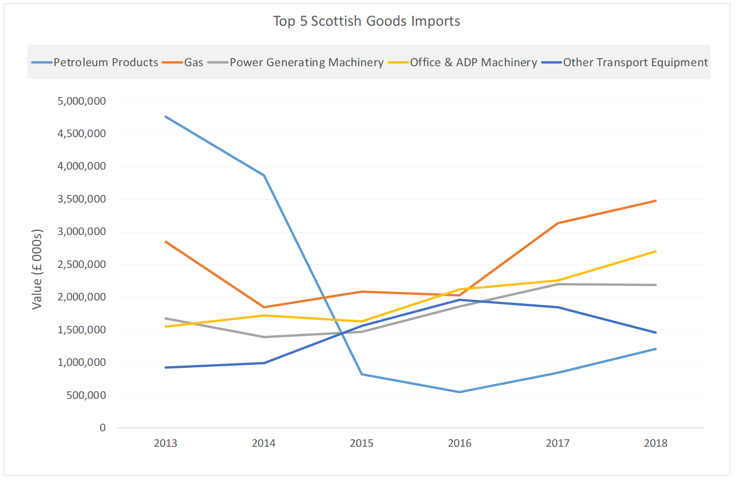
Goods imports in 2018 have increased for all of Scotland's top 5 goods types compared to the previous year, except for other transport equipment. Petroleum products have seen a sharp fall from nearly £4.8 billion in 2013 to just over £1 billion by 2018. This is largely due to a shift away from oil based imports from Norway, to natural and manufactured gas imports.
Looking at transport, road vehicle imports into Scotland come primarily from the Netherlands, France and Germany. In 2018, the combined value of road vehicle imports from these countries was £224 million. Overall, the value of road vehicle imports increased by 20% in 2018. This was greater than the growth in road vehicle imports over the previous four years.
3.3 Tourism
The International Passenger Survey (IPS)[21] produces estimates of overseas visitors to the UK, with disaggregated data available for Scotland. Data shows that overseas visitors typically come from countries with which Scotland has strong trade links. In 2018, 47.4% of visits to Scotland came from one of the 7 countries in either Scotland's top 5 importers or exporters (China, France, Germany, Netherlands, Republic of Ireland, Norway and USA), and spent a combined total of £1.1 billion – 49.5% of all visitor spend in 2018.
Travel by plane is by far the most prevalent mode of transport for visitors to Scotland. Since 2002, the number of visitors travelling to Scotland by plane has more than doubled (increasing by nearly 150%) as both other modes have held broadly constant over the period. This is shown in the chart below.
Figure 7: Scottish Tourism: Number of Visits to Scotland by Mode of Transport
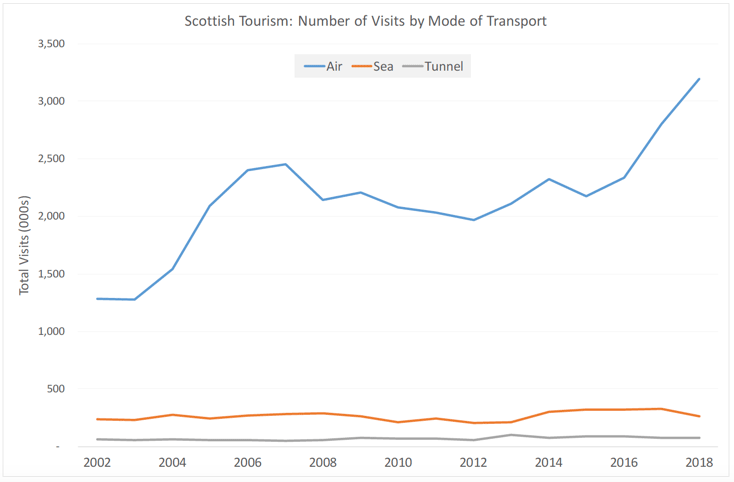
Over time, the pattern of tourist countries of origin has changed. The only constant throughout the 16 years to 2018 has been the USA remaining the top country of origin for visitors to Scotland. In 2002, a large proportion of tourists to Scotland came from outwith the EU, with USA, Canada and Australia all in Scotland's top 5 sources of tourists. By 2006, Australia and Canada had both fallen out of this top 5.
Other top sources of visitors travelling to Scotland include the Republic of Ireland, Italy, the Netherlands, Poland (5th most popular origin country for Scottish tourism in 2016) and Spain.
Global economic phenomena tend to impact tourist travel plans and destinations. During the financial crisis of 2007-08 and subsequent recovery, North American and Australian tourist numbers to Scotland dropped significantly, with Canada and Australia replaced in the top 5 by countries much closer to home, Italy and Spain.
Similarly, visitor numbers to Scotland from the countries hardest hit by the sovereign debt crisis – which resulted in slow growth across many Eurozone countries between 2011 and 2013 namely Italy, Republic of Ireland and Spain – reduced. In the case of Ireland and Spain, between 2011 and 2013, visitor numbers fell by 85% and 42% respectively.
By 2018, Scotland's top 5 included 4 EU countries, Spain, Italy, France and Germany.
Figure 8: Top 5 Countries of origin for tourist visits to Scotland over time
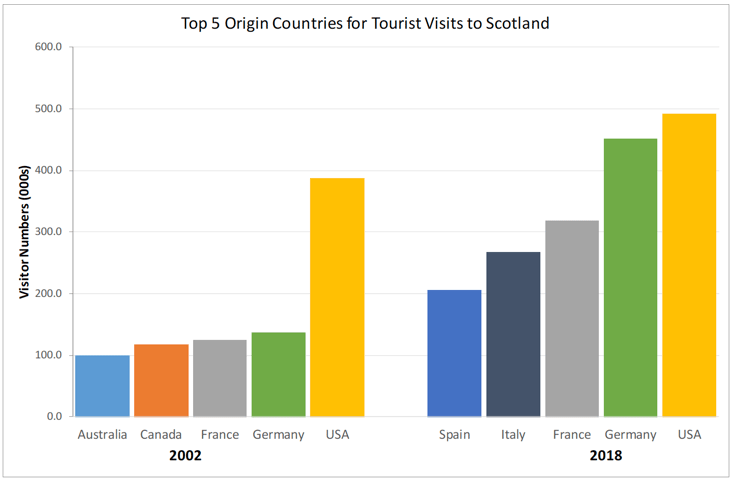
Tourists in Scotland stayed for an average of 8.2 nights in 2017. This fell to an average of 7.5 nights per visit in 2018. The average tourist in Scotland spent £88.20 each night in 2017, whereas this figure rose to £94.10 in 2018. Visitors from Bulgaria, Mexico and Pakistan had the longest average stays in 2018.
The biggest spenders in Scotland came from Saudi Arabia, Qatar and Japan. Visitors from these three countries combined spent an average of £214.80 per night in Scotland in 2018.